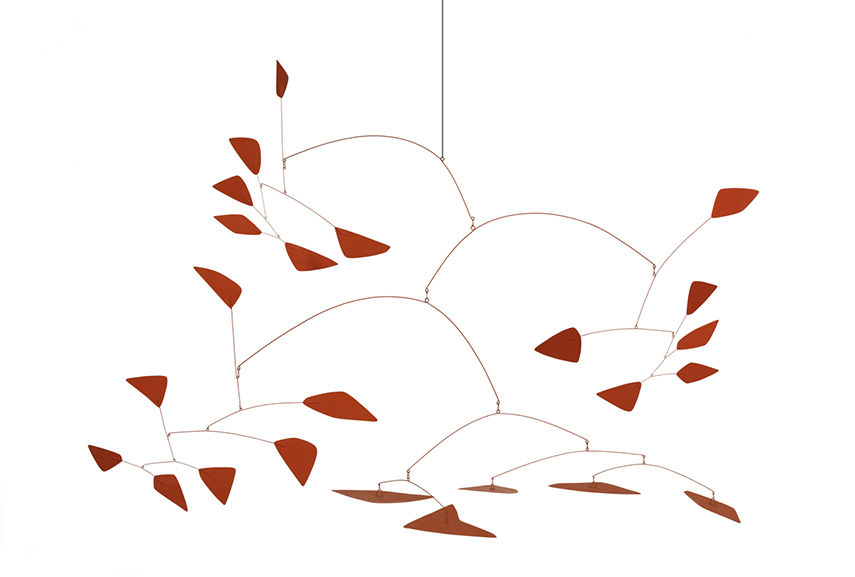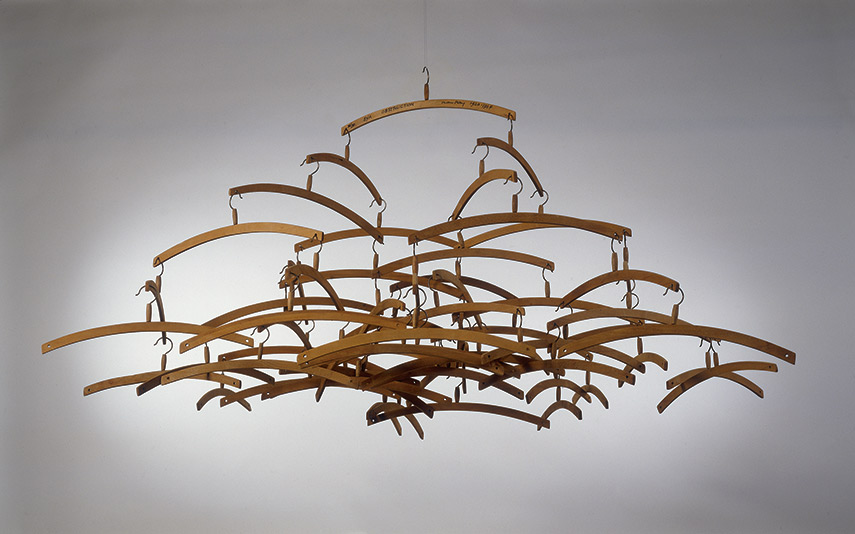In Terms of Art How Would You Describe Mobiles
Perhaps without being aware of it, many of united states of america have already come up across a piece of Mobile Art. Also known every bit mobiles, these structures are usually hanging above cribs and are designed to provide entertainment and visual simulation for infants. Still, their purpose doesn't terminate in that location, every bit many similar constructions make part of the creative interior decorating arts and are considered artworks at big, mainly thanks to the contribution of mobile artist Alexander Calder. What characterizes both types of mobiles is the fact they rely on balance and motion in order to achieve their artistic event; they are equanimous of a number of elements, usually abstract shapes, interconnected with wires, strings, metal rods or like objects. Equally such, they stand for a class of a kinetic sculpture because, dissimilar traditional sculptures, they practise not remain static, but are mobile, set in motion by air currents, a slight touch or even a small motor. The superb design of each of its parts, as well as the construction as a whole, manages to reach a kind of equilibrium that perhaps makes up the cadre of its marvellous aesthetics.

A Cursory History of Modern Mobile Art
The history of mobile art is quite a long one if we have into consideration that air current chimes are also mobiles. Their suspended tubes, rods, bells and other objects were assembled to create a sound deriving from contact between the elements, and people in Asia, Greece and Ancient Rome used to make them using drinking glass, bronze or wood. Wind chimes tin can still be found today, and in some cultures they are put on the entrance door for good luck, or even to send away evil spirits. Withal, it wasn't until the early on 20th century that mobiles became a role of the earth of the arts, through the works of Russian Constructivism artists and early kinetic mobile sculptures began experimenting with them: in particular the likes of Alexander Rodchenko, Naum Gabo and Vladimir Tatlin. In 1920, Surrealism artist Human being Ray introduced what could exist considered the get-go case of Mobile Art - entitled Obstacle, information technology was an associates of 29 coat hangers based on the whippletree, a force machinery attached to horses or mules that pull a turn or a wagon. Using the aforementioned rules of physics, the sculpture creates a remainder thanks to an evenly distributed forcefulness through its linkages. A decade later on, Italian designer and artist Bruno Munari made his Useless Machines, or "Macchine Inutili", made in cardboard and bright colors and designed to interact with their environment. And and so, in the 1930s, the meaning and the purpose of sculpture as an artistic medium was shaken to its core past Alexander Calder'south innovative hanging mobile designs, which we at present know every bit the true mobiles and the proper products of Mobile Art.

The Revolutionary Mobiles of Alexander Calder
In 1943, Albert Einstein visited the exhibition of hanging artworks by Alexander Calder at the Museum of Modern Art and famously said: "I wish I had thought of that". If this isn't acknowledgment enough of what his mobiles achieved, I'm not certain what is. Indeed, what makes the kinetic pieces of this remarkable artist so groundbreaking is the fact that he was a curious and experimental mind. He also explored the possibilities of the whippletree mechanism, but instead of attaching lower elements to both ends of the carrying element, he replaced them with abstract shapes. This, naturally, opened up an unabridged universe of artistic combinations and ideas, which the artist did not hesitate to employ for the next 4 and a half decades of his career, until his death in 1976.
Be sure to cheque out more works by Calder on our market place!
In 1931, Marcel Duchamp coined the term "mobile", using it to describe the artist's early, mechanized pieces and defining motility as their crucial characteristic. These artworks were influenced past the abstruse piece of work of Piet Mondrian, Joan Mirò and Sophie Taeuber-Arp, who all used geometric figures and simple colors in their paintings. He transmitted this kind of brainchild through shapes moving in space, usually fabricated of canvas metal, painted in the same colors and sometimes accompanied by unlike objects, such every bit textile, rubber, cork and constitute items. His mobiles were manipulated by means of cranks and motors and somewhen became his signature artworks, irresolute the way sculpture is perceived equally a medium. What's interesting is that he emphasized the importance of the machines in his Mobile Art, as an important new factor in the future of human diplomacy, and often described his pieces as useless and meaningless. "It's just beautiful, that'southward all. It tin can make you lot very emotional if y'all sympathize it. Of class, if information technology had some meaning information technology would be easier to empathize, but it'south likewise late for that."
Alexander Calder ended up making thousands of these useless and meaningless hanging mobiles, from miniature pieces to unabridged installations upwards to 100 feet in height. They're also highly popular amidst collectors; in 2014, his 1957 Poisson Volant was sold for whopping $26 1000000 at Christie's New York.
Video - Alexander Calder Mobile Art piece entitled Poisson Volant, 360 View
Mobiles Today
Because of Alexander Calder'southward absolute say-so in Mobile Art, non many others today cartel trying their luck in this creative field, and if they do, they usually just stop up being compared to him in an unfavorable way. All the same, the evolution of design from modern to contemporary throughout the 20th century, of course, provides with many possibilities, in materials, methods and visual aspects alike. Mobiles remain a unique form of art that could exist adjusted and customized to fit whatever fashion and space, and as such they are timeless and evergreen. Today, there are a few talented mobile creatives who were not intimidated by the powerful legacy of the father of mobile. Among them, we have Joel Hotchkiss, who has been making hanging kinetic compositions out of materials like natural metal and colourful fabrics since the early 1980s; Marco Mahler, with his smaller fine art sculptures and large custom-made mobiles, every bit well equally 3D-printed pieces, in collaboration with Henry Segerman; handmade designs past Julie Frith, Joseph Craig English language'southward artworks inspired by Matisse's jazz cutouts, the intrinsic constructions by Timothy Rose, kinetic works of Carolyn Weir…

Editors' Tip: Alexander Calder: Performing Sculpture
Alexander Calder: Performing Sculpture provides detailed insight into a pioneering process undertaken by the mobile artist: rather than simply refashion sculpture's traditional forms, he envisioned entirely new possibilities for the medium and transformed its static nature into something dynamic and responsive. Aside from the reproductions of personal drawings and notes, the publication also features the new research from a wide range of renowned scholars, furthering our understanding of the remarkable depth of his beloved mobiles and entrenching his status every bit an icon of modernism. It gives an insight into how his training as a mechanical engineer influenced him to develop a characteristic class of mobile and kinetic sculpture that turned him into one of modernism's nigh captivating and influential figures.
All images used for illustrative purposes but.
Source: https://www.widewalls.ch/magazine/mobile-art-mobiles-kinetic-art
0 Response to "In Terms of Art How Would You Describe Mobiles"
Post a Comment